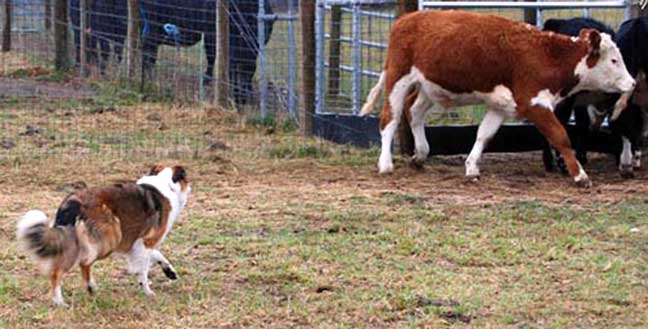

![]()
BORDER COLLIE COUSINS
THE ENGLISH SHEPHERD

Mary Peasley's Honey, an English Shepherd, shows her worth on stubborn calves
at Shepherd's Way in the Willamette Valley, Oregon. (Photo courtesy of Mary Peasley.)
The English Shepherd is descended from the old working collies brought over to America from Britain during the 18th and 19th centuries by farmers and ranchers for use as farm dogs. Some lines go back to black-and-tan collies bred by Tom Stodghill (1903-1989) of Quinlan, Texas. These dogs were said by some to have been first brought into the country by Henry Clay (1777-1852, the American statesman), who was a great, great uncle of Tom Stodghill, and by Stodghill's great-grandparents. Stodghill incorporated the English Shepherd Club of America in 1950, but he is out of favor today for creating what he called "the All-American Shepherd," a cross between an English Shepherd and a Border Collie, and for his rather odd breeding and training ideas. Others consider Dunroven's Ole Shep (see the Old Time Farm Shepherd) to be the progenitor of the breed. Indeed, different lines probably can be traced to different origins.

Once the calves are moving in the right direction, Honey backs off. (Photo courtesy of Mary Peasley.)
As an article in Dog World showed, the American collie breeds were not all that distinguishable even as late as 1937, when the American Kennel Club was preparing standards for breeds they hoped to "recognize" in the future. The dog pictured looks like a Border Collie, stands like a Border Collie, head lowered and intense, and is described as having been variously called "the American shepherd, farmer's shepherd, English shepherd, and border collie."

Honey keeps well back when herding sheep. (Photo courtesy of Mary Peasley.)
The English Shepherd is primarily a loose-eyed, upright worker similar to the Welsh Sheep Dogs of today. They are valued for their ability to work all types of livestock, for their strong guarding instincts, and their hunting ability, making them a general, all-purpose farm dog. They can also be quite independent with a somewhat strong willed temperament. In general, the English Shepherd comes in a wider range of sizes than the Border Collie, and males are larger than females. In looks they are similar to the Border Collie, but many have a more "old-fashioned" look about them, that is, a broader skull and ears carried lower at the side of the head. They come in fewer colors than the Border Collie, usually black-and-tan, tricolor, black-and-white, and sable-and-white, never merle, and they are never smooth-coated.
The English Shepherd Club is a registry "dedicated to the support, preservation, and responsible promotion of the English Shepherd breed and its natural working instincts". There are no show English Shepherds, and despite the AKC's rosy outlook, they are not yet recognized. Their proponents will undoubtedly fight tooth and claw to prevent that from ever happening, because with recognition as a show breed, diversity begins to be lost. Currently, there is also a breeder of English Shepherds in the UK.

National English Shepherd Rescue
"Standard of English Shepherd", Dog World, 1937.
Stodghill, Tom. "About the All-American Shepherd", Dog World magazine, 1957.
Copyright © 2013 by Carole L. Presberg
Return to
![]()
BORDER COLLIE COUSINS
THE OTHER WEB PAGES WE MAINTAIN
These web pages are copyright ©2013
and maintained by webmeistress Carole Presberg
with technical help from webwizard David Presberg
ALL RIGHTS RESERVED
If you are interested in using ANY material on this website, you MUST first ask for permission.